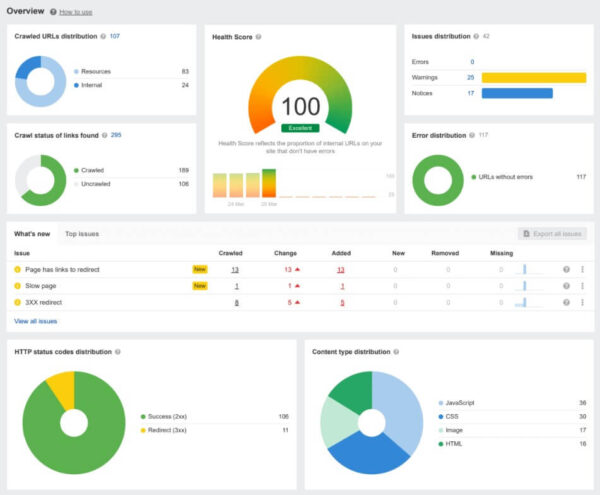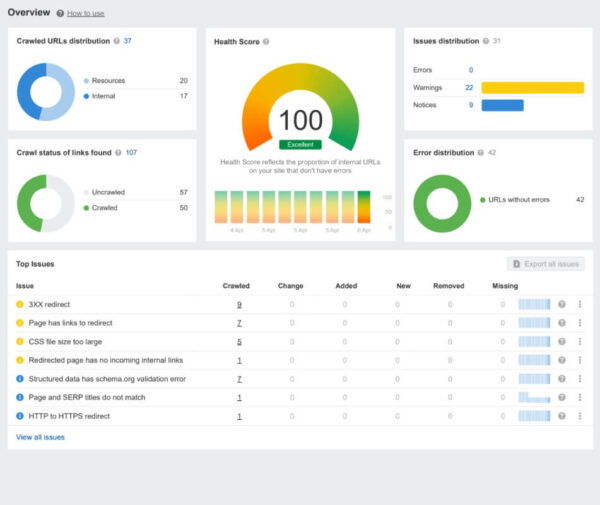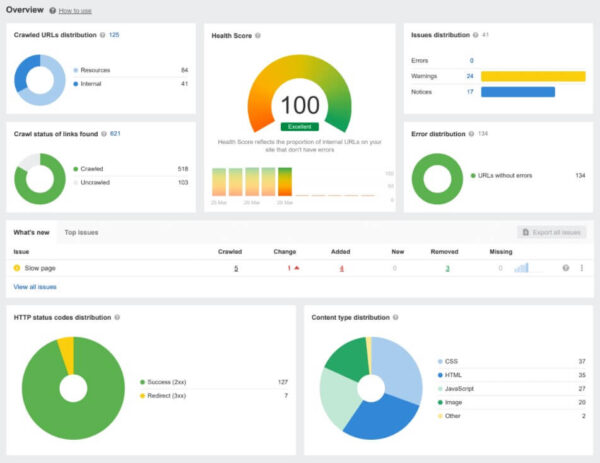Revitalize Online Presence with Expert SEO Audit Services
SEO Audit Service
$10 – $250
SEO Audit Service Features
Issues that we covered in our Audit scope:
(More information check the description)
Color code (Scope of this service)
- GREEN (Audit + Fix in this service)
- BLUE (Audit + Fix in other service)
- ORANGE (Audit only, Not including Fix)
1. Crawlability
2. HTTPS Status
3. Mobile Friendliness
4. Redirects
5. Meta Descriptions
6. Headings
7. Internal Links
8. Orphan Pages
9. Toxic Links
10. Content Quality
11. Duplicate Content
12. Indexability
13. Sitemaps
14. Robot.txt
15. Errors, Warnings, Notices
- Analysis using AHREF or SEMRUSH
- This service is only for CMS based sites
- Completion time: 2-5 days
Description
Optimize Your Site with the Best SEO Audit Service
It is essential to adopt and follow proper rules for a healthy online presence. There are more than 100 million active websites on the internet today and this raises the question; how do you fight for your site to be seen? The answer lies in availing itself of a professional SEO audit service in order to ensure that the site can be optimized to the maximum extent possible on the specifications of the search engines.
What is an SEO Audit Service?
An SEO audit is a comprehensive analysis of a website to determine its level of compliance with SEO standard guidelines. This is in essence an audit of your website to determine any problems which may be causing your website to underperform in SERPs. This process involves looking at multiple aspects of your site to ascertain that they are running correctly.

Essential Elements and Scope of Our SEO Audit Service
HQ Traffics’ SEO Audit Service offers a comprehensive approach to improving your website’s performance. The color legend helps you understand the scope of each service and ensures you know exactly what to expect:
- GREEN (Audit + Fix in this service)
- BLUE (Audit + Fix in other service)
- ORANGE (Audit only, Not including Fix)
1. Site Health
Overall Site Health Score
Health Score: A number that reflects the overall state of your site, which is based on the rate and number of the identified SEO problems. Health status increases as the values increase.
Error, Warning, and Notice Categories
Errors: Issues prominently affecting SEO performance, including large-scale crawl problems or the lack of meta tags in critical web pages.
Warnings: Issues that are not critical, but still relevant, such as a lack of alt texts or some small mobile usability issues.
Notices: Issues that are not crucial and do not significantly affect the site in the short term but that should be addressed to help the health of the site in the long term, such as title tags that are a bit long.
2. Technical SEO
Crawlability
Crawl Errors: problems that make it difficult for the search engines to crawl your content
HTTPS Status
SSL Certificate: Check that the site you manage has a proper SSL certificate so as to create a proper connection that is essential to the users and the search engine.
Mixed Content: Shows cases where secure (HTTPS) pages are downloading insecure (HTTP) resources and leading to security warnings in browsers.
Page Speed
Load Time: This tells you how long it takes for your pages to load and which components are slowing it down, such as images, files, or JavaScript.
Performance Metrics: indicators of how fast the site loads and how it reacts to user actions, directly affecting the user experience and ranking in search results.
Mobile Friendliness
Responsive Design: Verifies whether or not your site is responsive to various screen sizes and devices.
Mobile Usability: Problems that affect the usability of mobile devices, such as small font sizes, tightly spaced controls, and incorrect viewport configurations, which affect readability and usability.
Redirects
Redirect Chains and Loops: This occurs when there is more than one redirect chain between the initial URL and the final page or when the redirection results in a loop, respectively.
Broken Redirects: Broken links that may have resulted in a ‘404 not found’ page or any other relevant wrong page.
3. On Page SEO
Title Tags
Missing Title Tags: Discovers pages that lack the title tag, which is essential for the search engine schemes and positioning.
Duplicate Title Tags: Looks at pages that have the same title tags which can definitely create keyword issues on the search engines.
Title Length: Checks titles for relevancy and suitability: checking for optimal length and presence of specific characters that make it too short and hence less informative, and when too long, it gets truncated in search results.
Meta Descriptions
Missing Meta Descriptions: Make sure that individual pages of the website have a meta description that helps boost the click-through rate generated by the search result.
Duplicate Meta Descriptions: Find pages, which have the same meta descriptions and create issues with the tiny distinction achievable in meta descriptions.
Meta Description Length: Quick check if meta descriptions are within the recommended length of between 150-160 characters so that they can easily be seen by users in the SERP.
Headings (H1, H2, etc.)
Missing H1 Tags: Check whether each page is provided with an H1 tag in order to set the topic of the page.
Duplicate H1 Tags: Problems like H1 repetition, which means finding pages with the same H1 tag which decreases the importance of the headings.
Heading Structure: Permits correct utilization of head tags consisting of H1, H2, H3, and that kind which helps in coating up the hierarchical perspective each for SEO objectives and for enhanced readability.
Content Issues
Thin Content: Discovers webpages with little content since low-quality webpages are detrimental to rankings and offer minimal value to the client.
Keyword Optimization: Help to work the keyword into the textual content material without going overboard, which is detrimental.
Content Readability: Check readability using other techniques such as applying the Flesch-Kincaid score in order to meet the comprehension level of the intended audience.
Missing Alt Text: Can identify images that do not have alt attributes, which are required for accessibility and search engine optimization.
Oversized Images: Locates big images that have an impact on the overall site speed and suggests optimization.
4. Internal Linking
Internal Links
Internal Link: Structure Checks that all designated internal pages are easily accessible and checks that there is appropriate utilization of link juice.
Anchor Text: Checks the descriptions that are put into anchor texts of internal links to make them well-optimized and not appear too natural.
Orphan Pages
Identification of Orphan Pages: Identify the pages that are not linked to any other pages on the rest of the site and hence are not easily accessible by the search engines for indexing.
Linking Recommendations: Provides suggestions on how the orphaned pages are connected to the rest of the content such that they will be indexed.
5. Backlinks
Backlink Profile
Quantity and Quality: Provides the total number of backlinks along with more specific characteristics such as domain authority, trust flow, and relevancy.
Referring Domains: Comes with statistics on the total number of referring domains that link to your site, which helps increase rank.
Anchor Text Analysis: Check whether the anchor text of backlinks is diverse and suitable enough, without using too many optimized links as they can be considered spamming.
Toxic Links
Identification of Toxic Backlinks: Locate all links pointing to your website from irrelevant spam websites that can negatively affect the site’s reputation.
Disavow Recommendations: Helps in establishing which links to ignore as per the Google’s Disavow Tool to avoid negative impacts on the site.
6. Content
Content Quality
Content Depth: Assess the coverage of your content to determine whether you’ve covered the feat adequately and if your content is valuable to readers.
Relevance and Originality: Refer to the topics previously discussed to make sure that content is interesting to the target audience and that it is not a copy of some other content as it may lead to penalties.
Duplicate Content
Detection of Duplicate: Shows internal and external duplicate and similar content that affects the SEO because search engines are unable to determine which version is the canonical one.
Canonicalization: Suggests the use of canonical links, which tell search engines which of the involved links is the original one, useful for solving the problem of identical content.
7. User Experience (UX)
Core Web Vitals
Largest Contentful Paint (LCP): Assesses loading performance, with an ideal value of LCP happening in less than 2.5 seconds of when the page initially loads.
First Input Delay (FID): Covers interactivity with less than 100 ms for FID making sure that the users can interact with the page.
Cumulative Layout Shift (CLS): Used to measure the visual stability so that CLS should be as low as 0.1 to avoid situations where the page appears to move or reorganize itself during loading.
Navigation
Ease of Navigation: Define the extent to which users can easily subconsciously navigate your site, thus influencing usability and interest.
Site Structure: Ensures a structural coherence, which allows for easy identification of information relative to user goals, and is appropriate for SEO.
Design and Layout
Aesthetic Appeal: Assess the aesthetical aspect of your site and particularly the professional look of your website which helps to build users’ confidence.
User Engagement: Defines the activity of users as bounce rate, time spent on the site, and the number of pages per session to establish their interaction with your content.
8. Indexability
Indexation Issues
Pages Not Indexed: Find pages that do have no visits from search bots and explain the causes, like no index tags, bot errors, or weak internal linking.
Indexation Status: Check the index status of your individual pages with Google Search Console for important pages to make sure they are indexed on the search engine.
Sitemap and Robots.txt
XML Sitemap: It is recommended to ensure you submit the latest XML sitemap to the search engines so that they help crawl the pages.
Robots.txt: Check your robots.txt file for any problem that might hinder the crawlers from accessing some of the pages to make sure it is well set.

7 Benefits of an SEO Audit Service
Let’s delve deeper into the tangible benefits that an SEO audit service can bring to your business.
1. Improved Search Engine Rankings
The first advantage of a comprehensive SEO audit is the possibility of increasing positions in search engine rankings. This involves enhancing the internal and external optimization factors of a given website to increase its ranking in SERPs. This includes fine-tuning text, headers, footers, and other components to make your site as ready for SE as possible. It is a great thing to rank higher because this results in more clicks, organic traffic and can directly affect your profits.
2. Enhanced User Experience
The user experience will help make sure that visitors to your site remain on them and perform the intended actions. Technical audit is vital in fixing issues that affect UX, including site speed and mobile-friendliness. Thus, if you pay close attention to your site’s loading time and menu structure, it is possible to create improved experiences for users. It also helps keep the visitor engaged and in turn reduces bounce rates whilst increasing the opportunity of conversion.
3. Increased Website Traffic
Certainly, better rankings do translate to more traffic through the organic search results. Keyword optimization and content strategy are key factors in any SEO audit to influence more traffic to the website. This is not just about any traffic; it is about the kind of traffic that is likely to generate sales or conversions. The increased flow of the right users may result in the growth of activity, the creation of leads, and, therefore, sales.
4. Higher Conversion Rates
With higher ranks in the SEO results and clearly defined and more convenient navigation, the chances are that the number of sales will increase. If you want to learn how to do an SEO audit, be aware that it can greatly assist in the enhancement of landing pages and call-to-action aspects that allow website visitors to make a purchase or fill in a registration form or contact your team. It is possible to enhance your site’s performance by reducing friction, thus bringing it to the next level and achieving the intended goals.
5. Cost-Effective Marketing
It should be noted that SEO audit benefits can endure for a long time, unlike paid advertising, where you need to invest continuously. Essentially, having a consistent flow of visitors from the search engines will help to cut the reliance on paid ads and grow organically. This makes it Affordable, and thus SEO is a very effective Marketing tool with a high ROI. The choice to invest in an SEO audit produces even stronger returns in the long term because more and more people find your site through the search results, while organic traffic does not entail the constant spending on ads that paid traffic does.
6. Staying Ahead of Competitors
Periodical SEO audits assist you in evolving ahead of your rivals by ensuring your strategies are relevant. The analysis of your site’s strengths and weaknesses in comparison with other similar sites helps to change the SEO strategy and keep up with the competitors. Knowing your rivals and your position in the SEO field can prove useful for making better decisions and grabbing new opportunities.
7. Actionable Insights
Possibly the biggest benefit of an SEO audit is that it offers recommendations for improvement. A general audit report includes the details of the recommendations to help enhance the performance of your site. It helps to avoid random actions and pinpoints changes which will be most effective according to the collected data. Such information should be useful for further SEO work and contribute to the successful implementation of business objectives.
Conclusion
As the pace at which the digital marketing landscape is constantly evolving, an SEO audit service aims to become a valuable asset for any eager entrepreneur. Conducting an SEO audit will assist you in pointing out technical and content drawbacks, and minor usability concerns that could be hindering your site.
Scheduling SEO audits on a consistent basis not only serves the purpose of improving the position of the website on search engine results pages and increasing the traffic but also improves the usability and contributes to the overall business objectives. Whether you are an experienced businessman or just a beginner, the SEO audit service is vital for the company’s development.
Additional information
| SEO Audit Packages | Audit Only (NO Fix), Optimize 50, Performance 100, Ultimate 400 |
|---|











